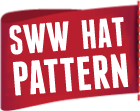
We caught up with this year’s patrons, the Shetland Guild of Spinners, Knitters, Weavers and Dyers, to find out more about the Guild, what it means to members to be awarded this role and how the design came about for the Aal Ower Toorie.
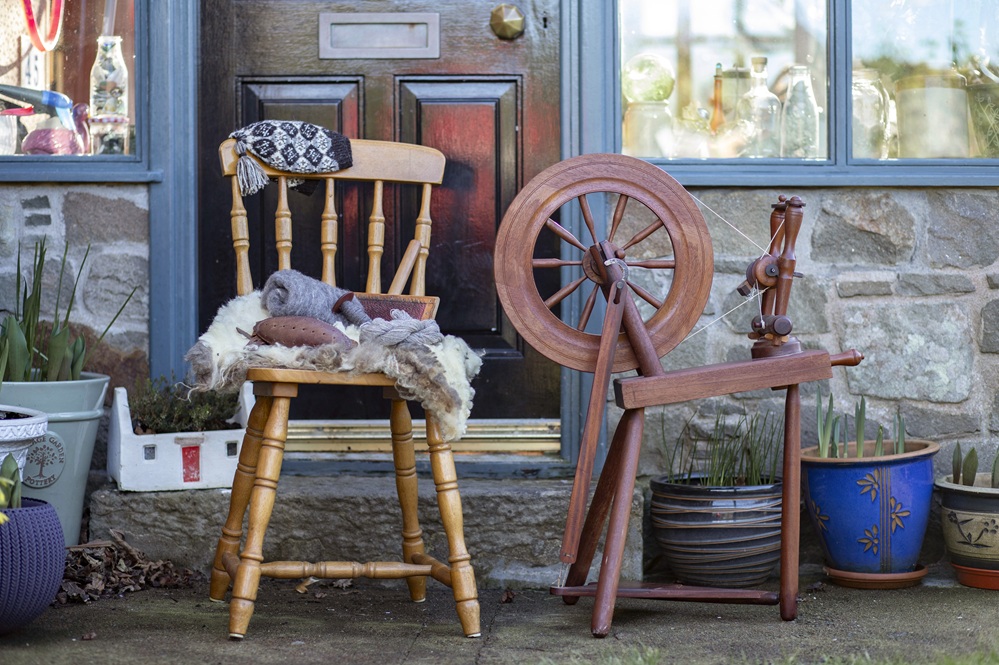
Congratulations on being named as Patrons of this year’s Shetland Wool Week! We know you’ve had to keep it a secret from your members up until now. How has that been?
It has been very difficult and challenging as we have been so excited. We haven’t told any untruths! But we have been guilty of guiding discussion away from Wool Week. We are now delighted to be able to share it with our wider membership.
What does being Patron(s) of SWW mean to the Guild?
It is a great honour and we are so delighted that the Guild membership’s knowledge and skills are viewed in such high esteem by the wider community of Shetland.
The Aal Ower Toorie is a stunning piece. Can you tell us about the design process – how did you go from concept to finished pattern?
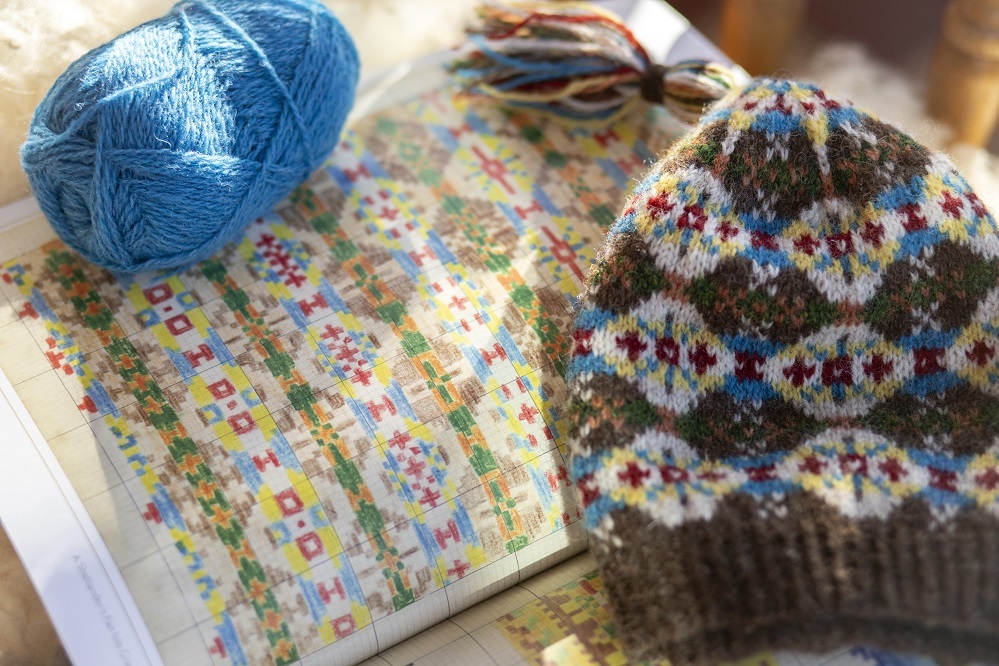
We were keen that the inspiration for our Aal Ower Toorie came from a Guild publication and we were drawn to A Shetlander’s Fair Isle Graph Book. We feel this publication is often less understood, particularly by non-Shetlanders, compared with our other books with set patterns. We were inspired by the All Over Exhibition at the Museum and also the fact that our members are from “aal ower” (all over) Shetland. We were also keen to get back to basics and showcase how traditional vintage patterns can be used in contemporary ways. The all over pattern we chose is a design which works horizontally, vertically and diagonally and this created a challenge given we were designing a hat pattern with a crown, rather than a larger item such as a jumper. The tassel is a slight nod to the traditional Fishermen’s Kep. (The pattern can be found on page 38 of A Shetlander’s Fair Isle Graph Book.)
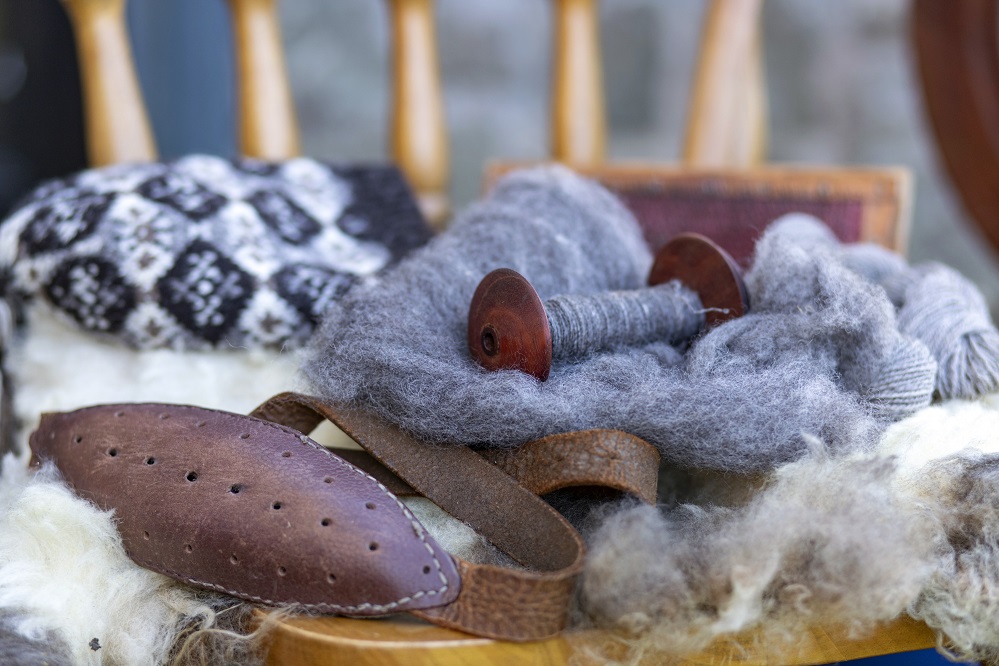
Were there any particular challenges in adapting a vintage Fair Isle pattern for a modern knitwear design?
Vintage patterns are normally well used and have worked for generations. The pattern we are using is most likely from the 1930s and was very popular up until the 1960s. There are no long floats (a short stranded knit) making the pattern very efficient as it can be knitted up quite quickly. The short floats make for a solid, almost double knit fabric and the frequent changes of colour makes good use of small amounts of wool. The main challenge was the crown given the design of the pattern works horizontally, vertically and diagonally and there were a few attempts until we were happy with the dynamic movement of the all over pattern into a circular crown pattern.
The name “Aal Ower Toorie” has a lovely double meaning. How did you decide on the name?
We wanted to recognise that our members come from all over Shetland and that we meet regularly all over Shetland. It has always been the intention that the Guild is a totally inclusive Shetland organisation, drawing on the different skills, techniques and patterns of the very different areas and islands which make up our wonderful community.
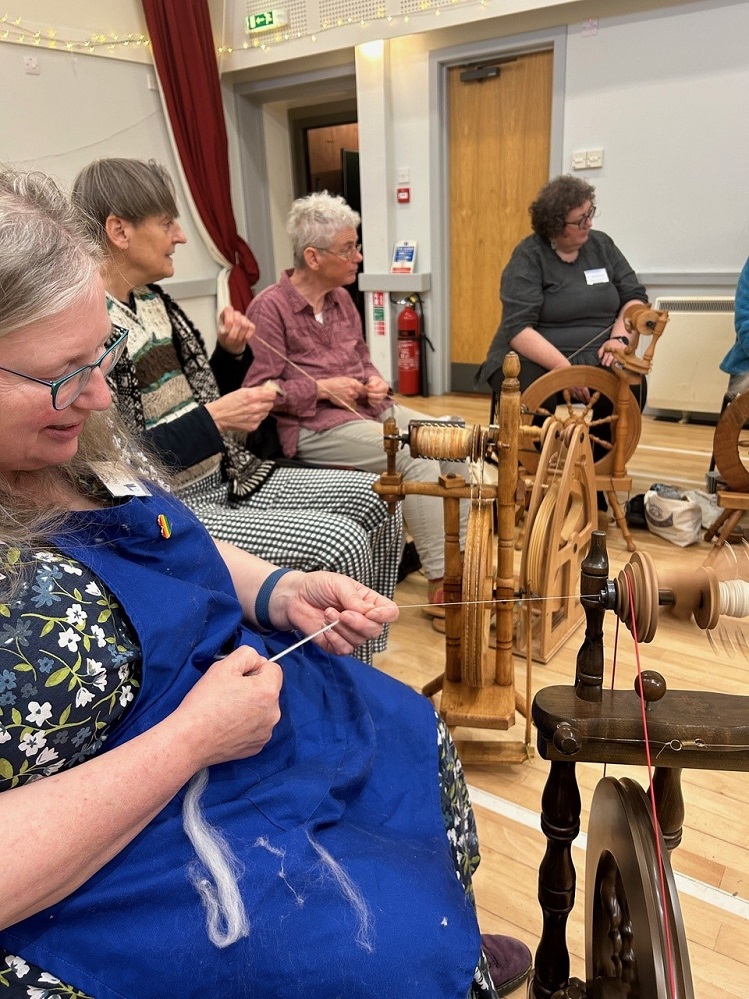
Members Spinning Meeting at South Nesting Hall Nancy Hunter, Beatrix Weber, Greet Blom and Rachel Hunter
The hat features an allover pattern from your Guild publication “A Shetlander’s Fair Isle Graph Book.” Why did you choose this particular pattern?
There are two or three all over patterns in the book but this particular pattern was chosen as it was pre-World War II and had a strong vintage feel. We have tried to replicate the pattern as far as possible. The colours look complex, but they are made up of primary colours, plus two secondary colours and two natural colours. The patterns that sit within each diagonal grid are all different so there are options for using the diagonal grid to add a different choice of motif and creating your own unique pattern. This all shows how this publication can be used to design your own knitwear and we hope this will inspire Wool Week knitters to be creative!
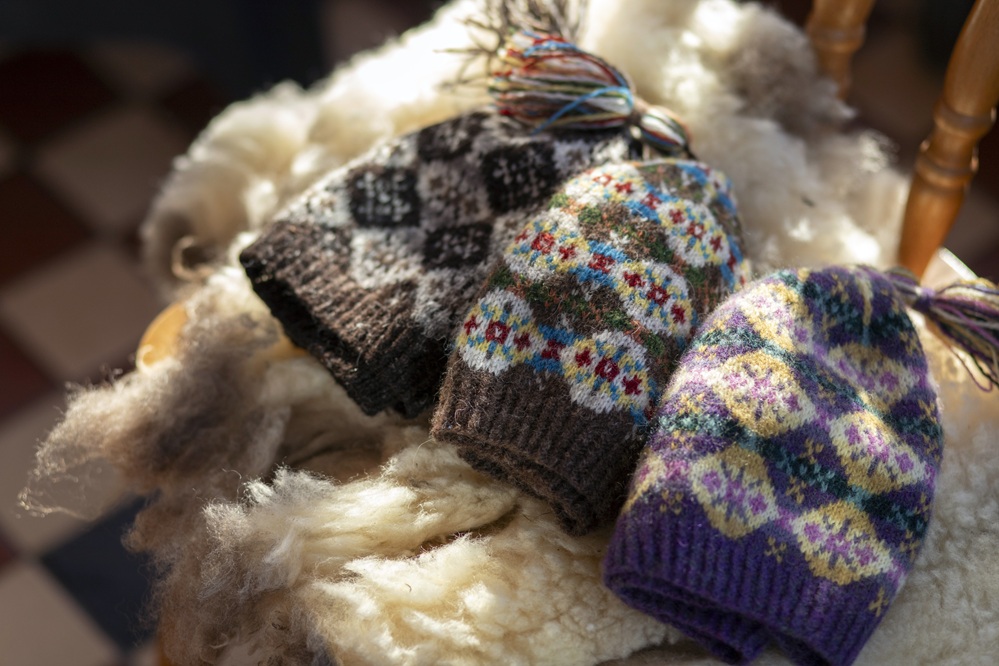
The colourways are all so distinct. Do you have a favourite colourway? Does each tell a different story?
Each colourway has its own characteristics and the three of us (Rachel, Elizabeth and Jennie) love all three versions. The vintage colourway shows how quite separate and strong colours can sit comfortably next to each other and uses colours that would have been available in the 30s, such as madder, indigo and gold. The Kaleyard colourway was not restricted by the colours in the chart book and so we chose a palette of colours that could be blended and graded. The Kaleyard colourway shows off the range of colours available today given current dyeing techniques and shows how well they can still be adapted into a vintage pattern. The Shetland undyed naturals always work well with each other but our choice to use Shetland Black as a background is to allow the lighter colours to shine. In our view the three different colourways demonstrate the versatility of fair isle – blended colours, juxtapositioned colours, vintage into modern into traditional.
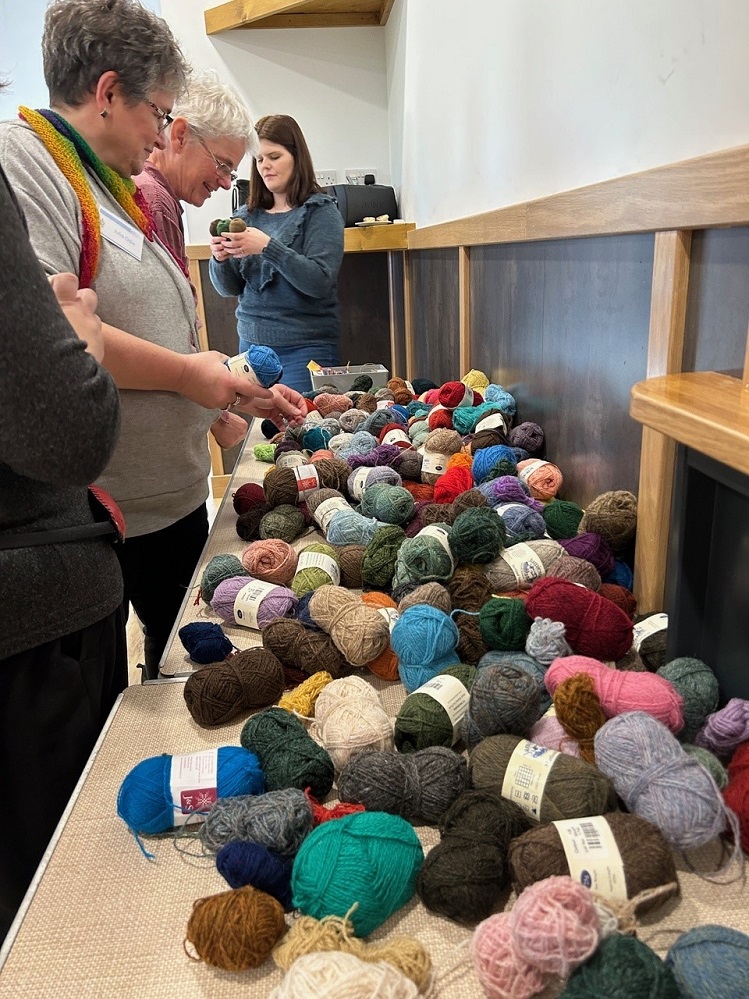
Learning colour skills from Terri Malcolmson at a monthly meeting
For those new to knitting Fair Isle, would it be possible to knit the Aal Ower Toorie using just two colours? How would people go about adapting the pattern to do that?
Yes, it is very easy to convert and adapt this pattern using just two colours. Using the Shetland Naturals Colourway, substitute Colours A and D for Colour 1 and Colours B,C and E for Colour 2.
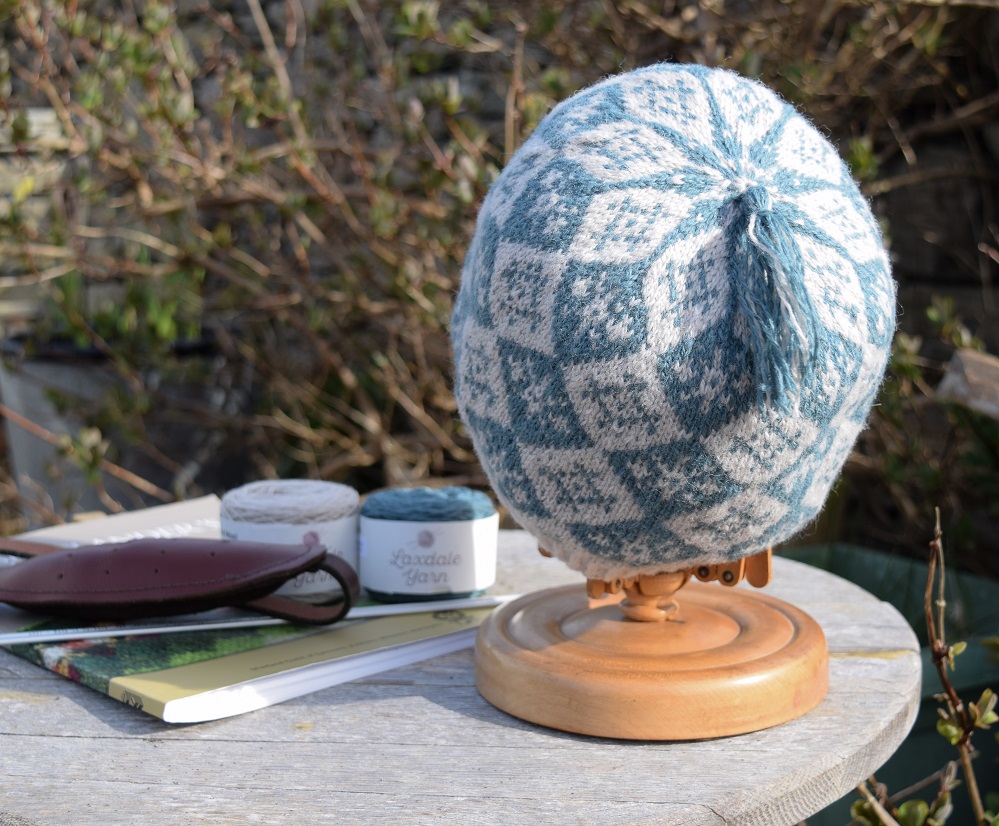
Two colour version in Laxdale Yarn
What advice would you give to knitters tackling the Aal Ower Toorie – any tips or tricks?
Knit a swatch! And wash and block it. This is really important not just for tension but also to check your colours. Knit a whole motif either in the round (on three needles or using the magic loop on circular needles) and using three or four steek stitches which can be cut to give a flat sample. Or knit flat using “brak an eke”. This pattern uses relatively small amounts of yarn and should provide many opportunities for experimenting with different colours in addition to using up small balls of leftover yarn from stash hoards. The main background colour uses 15g or less with 10g or less of the pattern colours.
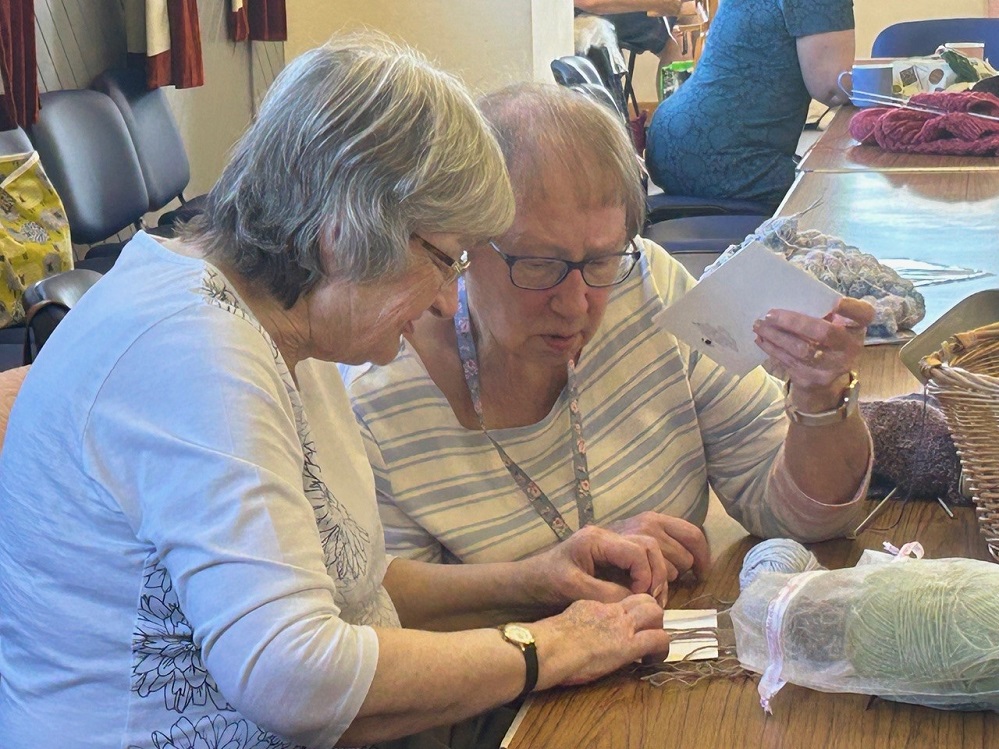
Members (weavers) Jane Baker and Glenda Smedley discuss colourways
Tell us about the Guild – how long have you been running for, how often do you meet and what do you typically do?
The Guild was established in June 1989 and has always had a healthy membership. In the last few years membership within Shetland has grown, with members coming from all over Shetland and across all ages. The culture of the Guild has changed over the years but our central core remains the same. We are passionate about what we do and love to share our skills. However, our central aim is to ensure that we continue to pass on traditional Shetland methods – the “Shetland way” – particularly for the key skills of spinning and knitting. We usually meet on the second Saturday of the month from 11am to 3pm at various community venues around Mainland Shetland and always have a varied schedule where we share skills and techniques and sometimes all knit a particular chosen pattern.
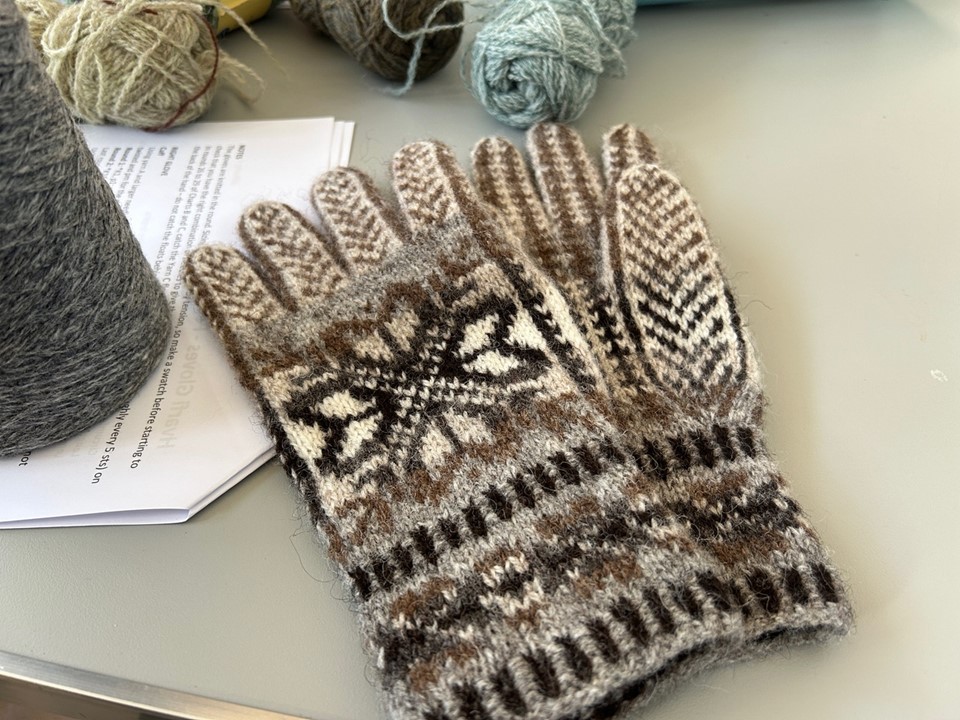
Last year’s Guild knitting challenge was Pearl Johnson’s very traditional Hvarfi Gloves from our publication Fair Isle Designs from Shetland Knitters Volume 1
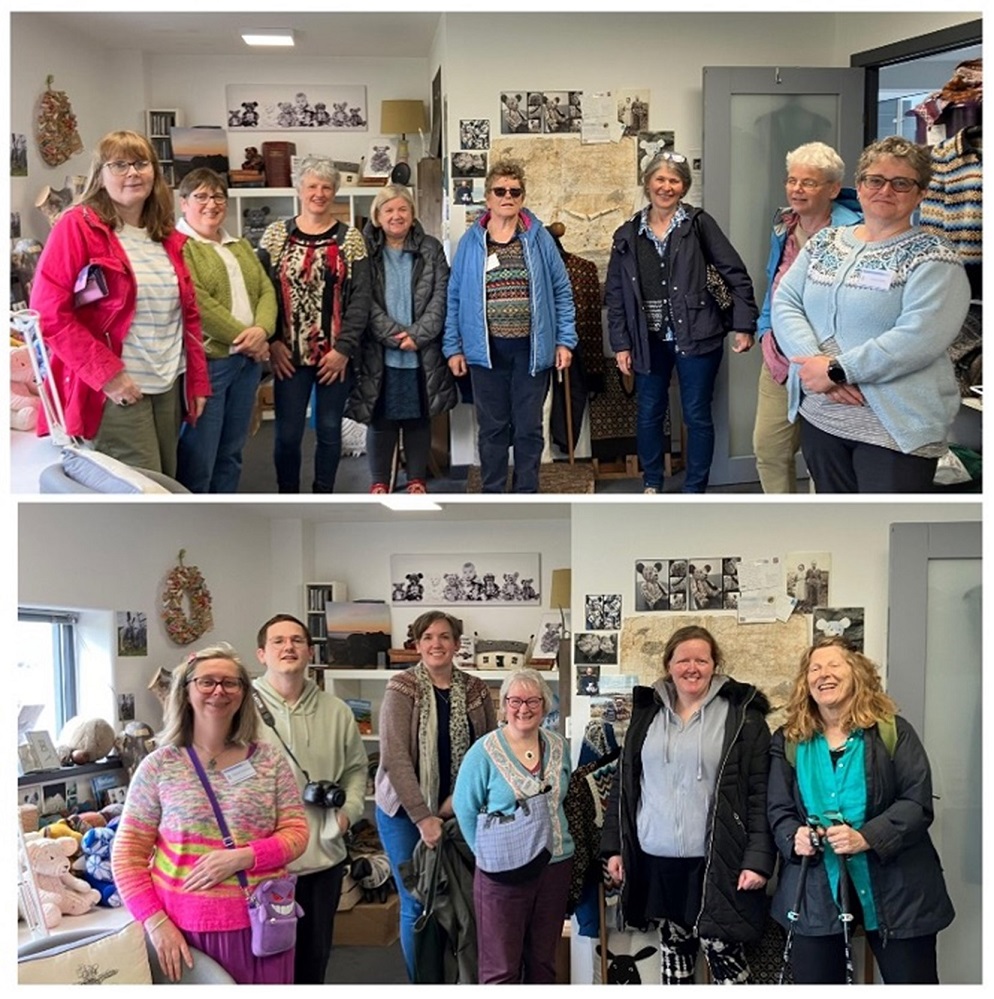
Summer outing to Burra to visit Burra Bears
We always have an Island visit in the summer visiting not just the outer isles but those closer such as Burra last year. This year we are excited to be holding a number of workshops for members that have been delivered by Shetland Tutors at Wool Week and which have proved very popular, again all continuing the core aim of traditional skills.

Member Jennie Atkinson (right) explains steering to a wool week visitor
The Guild has played a key role in preserving and promoting Shetland’s textile heritage. How important is it for the Guild to pass on traditional skills to new generations?
We are passionate about keeping the Shetland traditions alive and passing these on to younger generations and those moving to Shetland with an interest in learning the traditional skills. A significant number of members hold workshops at Wool Week sharing traditional skills in fair isle and lace knitting and spinning.
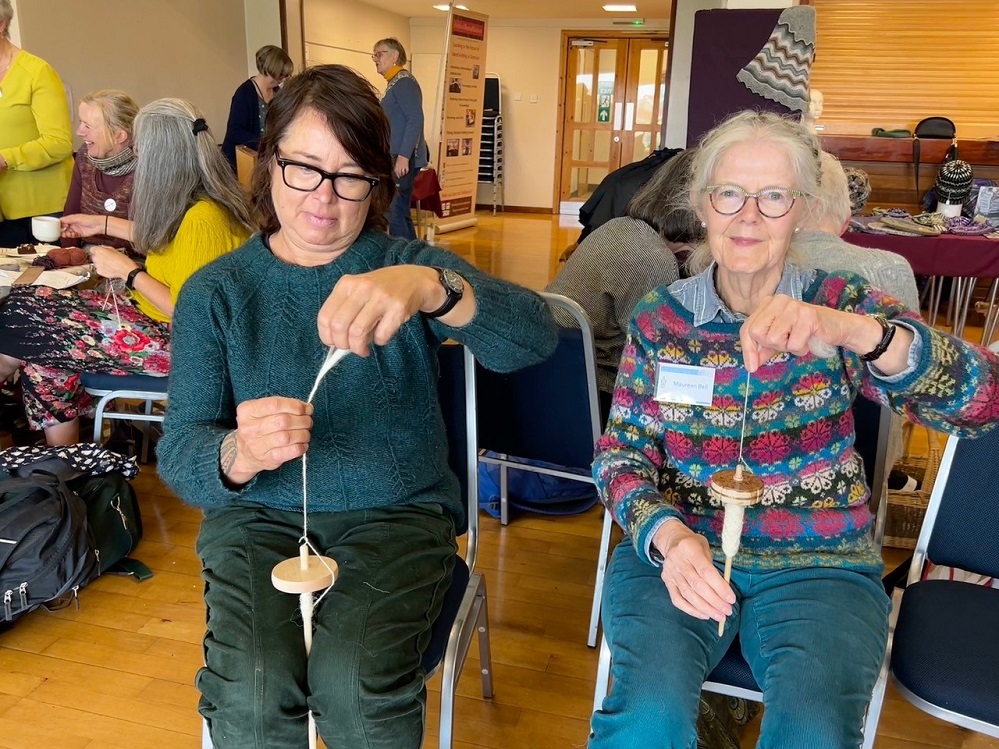
Member Maureen Bell with a Wool Week visitor spindle spinning at Meet the Guild Wool Week Teas

Members are also involved in demonstrating throughout the summer at The Textile Museum at the Bod of Gremista and running their own workshops. Some members are active in organising the traditional textile sections at the local Agricultural Shows with many more submitting entries into the shows.
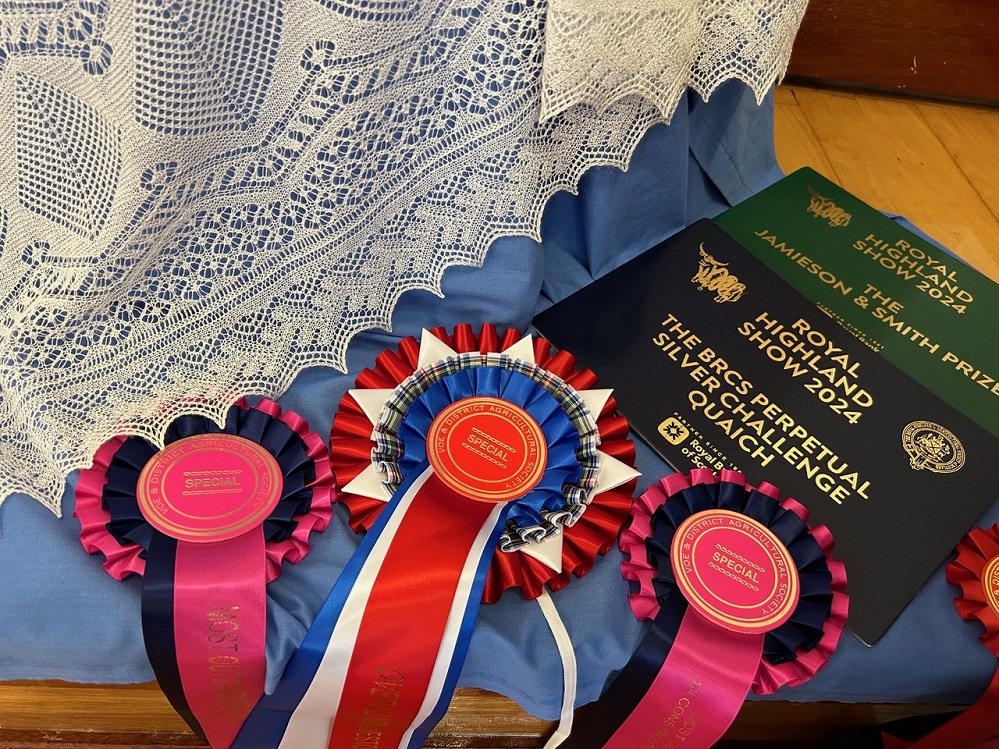

Award winning displays of Guild work
Are there any particular techniques or patterns that are unique to Shetland that the Guild works to keep alive?
A number of years ago we went down the route of publishing books in lace and fair isle knitting in order to ensure wholly traditional Shetland knitting techniques and patterns were documented and survive for the future from those who have learnt from the past. Patterns have always varied across the Isles – past generations of young girls learnt unwritten patterns from mothers, aunts and grandmothers and knitting had to be produced quickly to generate much needed income. So whilst today we knit for pleasure, in the past it was for survival and knitters worked with patterns they knew for both efficiency and speed. However, as with any other art form, over time some very creative knitters have come to the fore and have pushed the boundaries in the work they have produced. This can be seen particularly in Unst with the Sutherland family and their exquisite lace patterns. Black and white charted books of the more traditional patterns enabled a Shetland knitter to create their own design and didn’t inhibit using different colours as the colour charts of today tend to do. We encourage our members to experiment with pattern and colour and that is gloriously evident if you visit an Exhibition of members’ work. Traditionally Fair Isle is two colours in a row, short floats and patterns geometric, centred, mirrored and with close attention to symmetry, all principles we wish to ensure continue into the future.
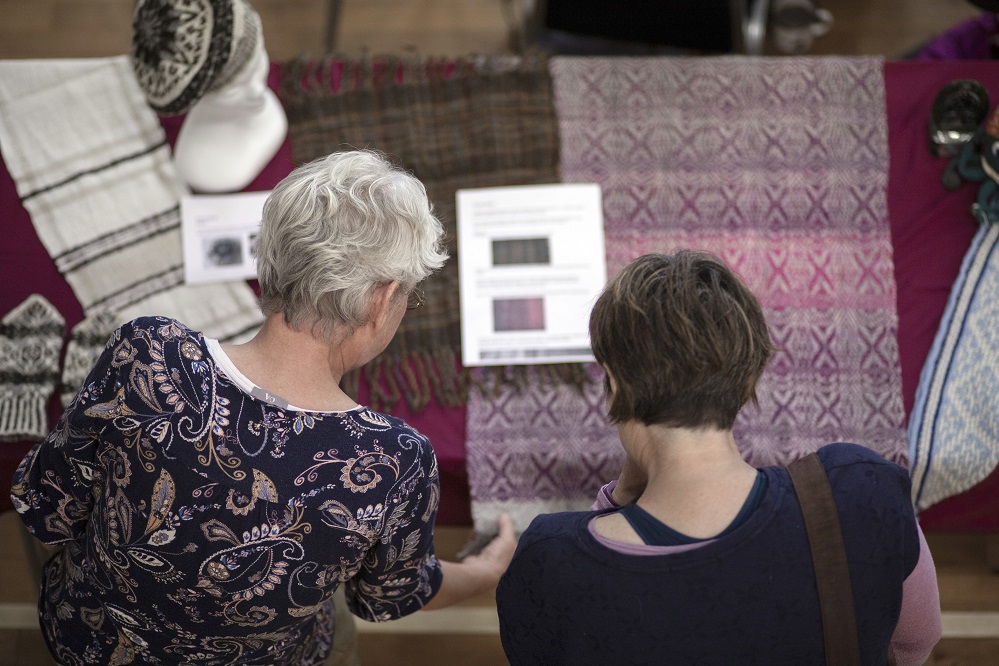
How do you see Shetland knitting evolving in the future?
Shetland knitting has continually evolved over time embracing new styles and technology but it has kept its base in the essential skills. It is good to see a younger generation of Shetlanders both wearing and knitting Fair Isle using traditional patterns. We hope that our choice of hat pattern shows how a vintage pattern is still relevant today in modern colourways.
What plans have you got lined up for Shetland Wool Week?
We will be holding our traditional Meet the Guild Teas at the beginning of Wool Week which we are holding in Lerwick this year in order to make it more accessible for a wider number of visitors. We have a significant number of members teaching workshops across spinning and knitting. We also hope to hold a Question and Answer session on spinning, knitting lace and fair isle. There will be a Guild presence in the Hub over the week and also at local Halls and Exhibitions throughout Shetland – in fact we will be Aal Ower Wool Week!
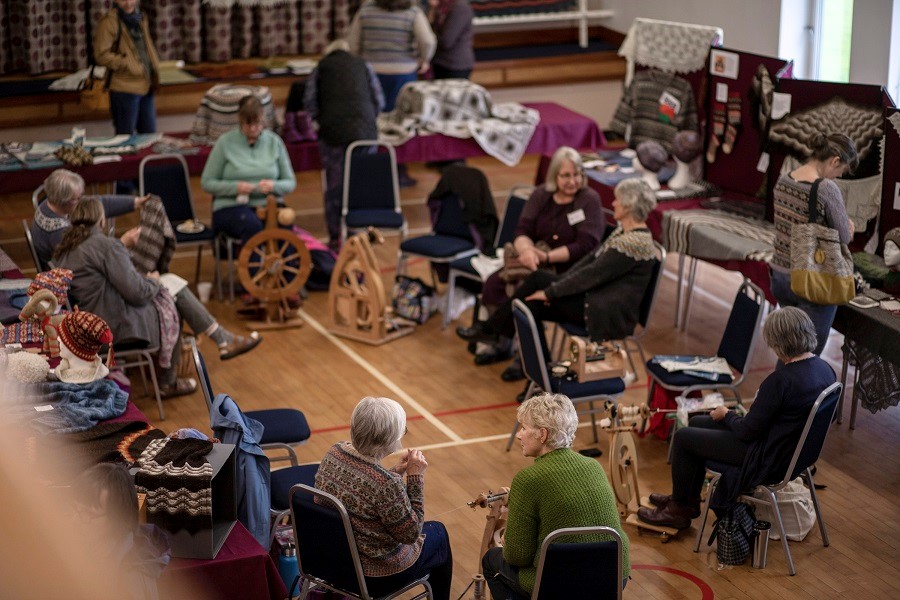
Meet the Guild Teas
The Guild Teas are legendary during Shetland Wool Week. For those who have never attended, tell us what goes on? Any highlights, or favourite recipes?
Centre stage of the Guild Teas is the Member’s Knitwear and Textile Exhibition – the breadth of skill and design is amazing. The main purpose of the event is to meet Guild members, see what they have been working with over the past year, and demonstrate and share skills, tips and techniques. We are complimented on the home bakes, but this popular event sees wool week visitors from all over the world enjoying the opportunity to sit and chat with like-minded people with a passion for Shetland textiles.
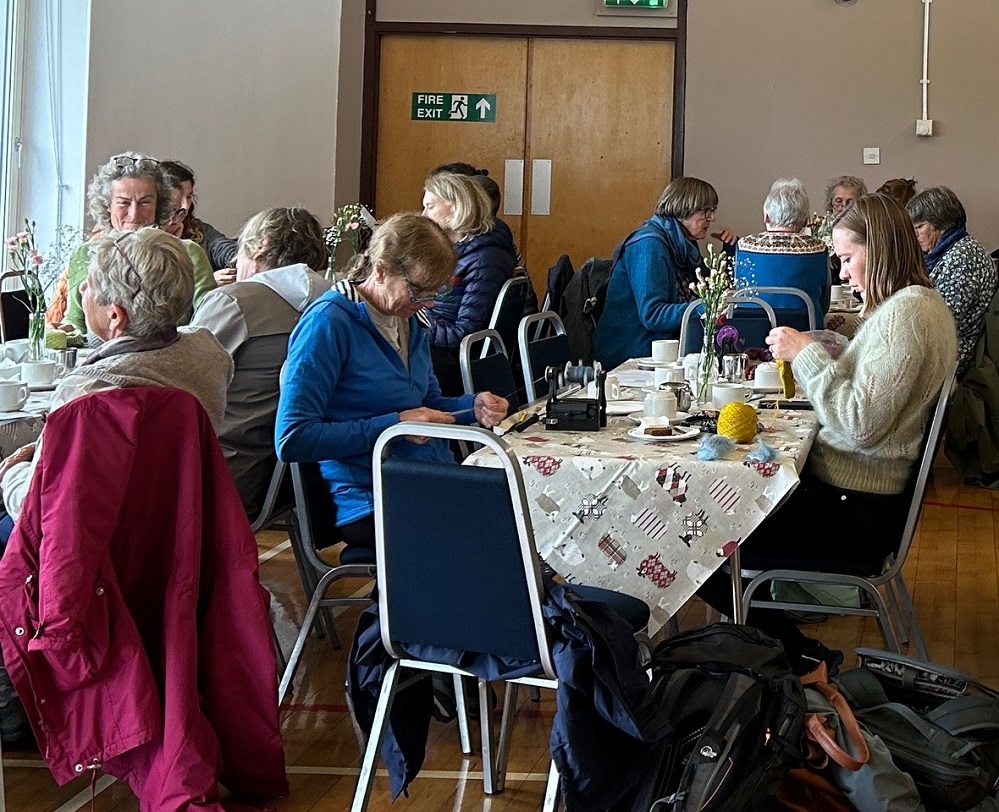
A relaxed atmosphere at the teas
Lastly, if someone is inspired by the Aal Ower Toorie and wants to learn more, how can they get involved with the Guild?
We would encourage anyone living in Shetland or who visits regularly to join the Shetland Guild and meet with us to learn new skills and techniques. For those outside Shetland and living in the UK there are a huge number of Guilds registered under the Association of Guilds of Weavers Spinners and Dyers (wsd.org.uk) and you are sure to find one in your own area. We would recommend our own Guild publications as patterns are included for beginners as well as intermediate and experienced knitters. There are three publications in addition to the Graph Book mentioned above: A Legacy of Shetland Lace, Fair Isle Designs from Shetland Knitters Volume 1 and Volume 2. All are available from the Shetland Times or directly from the Guild at any Guild event. Guild member Hazel Tindall and Elizabeth Johnston’s DVD 50 Tips from Shetland Knitters includes essential traditional knitting advice and Member Janette Budge has online tuition for using the knitting belt.
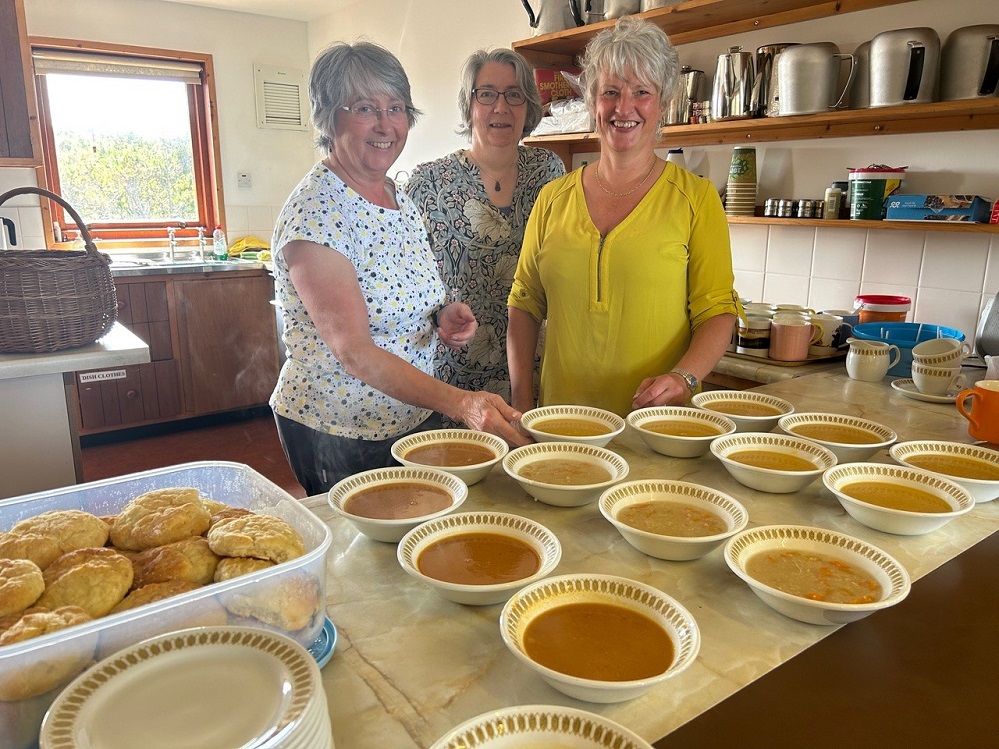
A special lunch is served at a monthly meeting : Karen Ashley, Elizabeth Williamson and Rosie Doull
More Aal Ower patterns coming soon…
We hope to share an additional pattern later in the year for wrist warmers and fingerless gloves using the Aal Ower Pattern and the leftover wool!
Follow the Guild on facebook and instagram, as they share updates throughout their year as the SWW Patron.
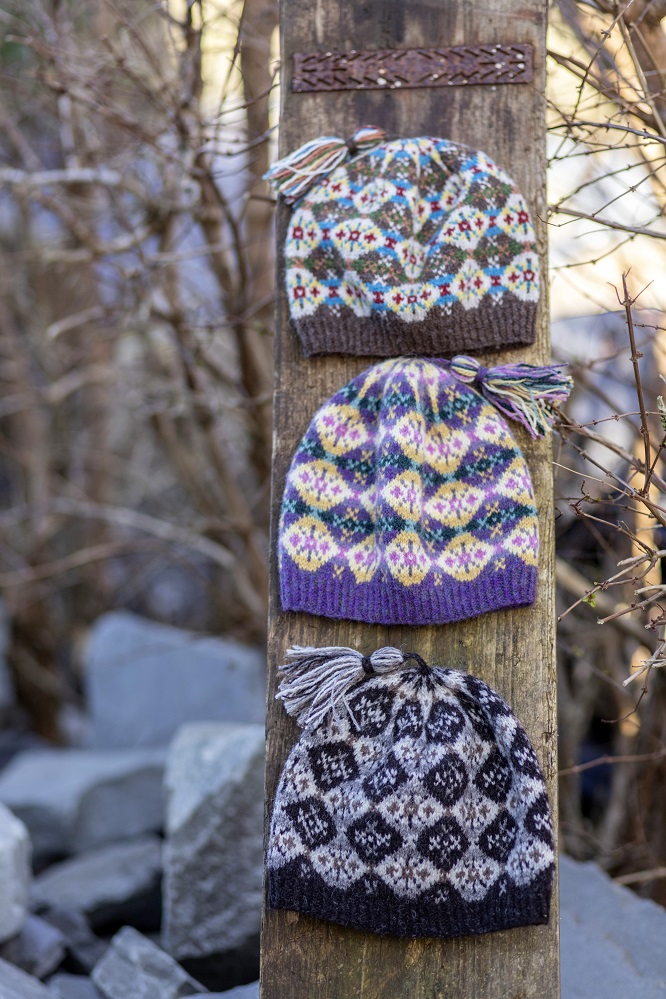
Remember to join the Aal Ower Toorie Knit-A-Long page on facebook, and share your creations with us on instagram using #aalowertoorie
Make sure you are following us on Facebook and Instagram to keep up to date with the latest SWW news and announcements.